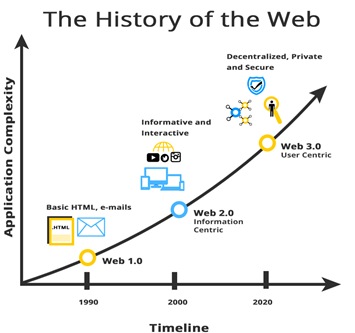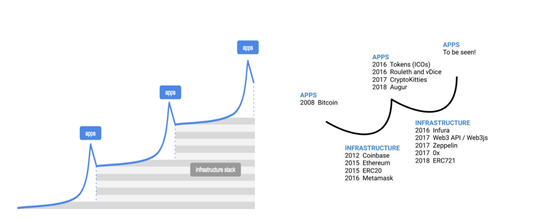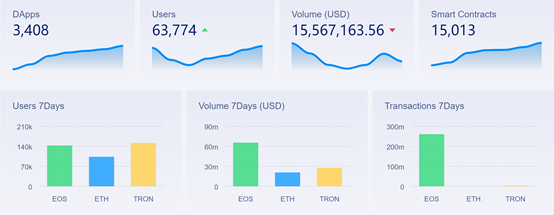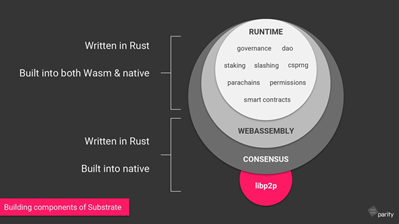Layer 3 middle layer: a new engine for Web 3.0 development?
Author: Howard
Source: Consensus Future
Foreword: The recent blockchain primary market investment is still very cold, but we still notice some financing progress on the dApp ecosystem. Binance announced last week that it has acquired the decentralized application analysis service platform Dappreview, a company that provides data for dApp users. Analyze services and help build a platform for the dApp developer community. In October, another dApp analysis and research company, DappRadar, received investments from Naspers (Tencent's largest single shareholder) and Blockchain Ventures. In addition to the $ 11.2 million new round of financing completed by September ’s development team of blockchain game leader CryptoKitties, Dapper Labs, led by A16z, and entertainment giant Warner Music Group also participated in the investment. dApp is an important embodiment of Web 3.0 distributed commerce. Institutions in the dApp field are raising. Does this mean that the next wave of blockchain development will be led by dApp?
I. Web 3.0 wave and development status of dApp
Web 3.0 is a concept frequently mentioned in the industry recently. In short, Web 3.0 means that the development of the Internet has entered an era of user-centric blockchain trust networks .
- Deputy Director of the Institute of Finance of the Development Research Center of the State Council: Opportunities and Challenges of Digital Currency
- Deep Analysis | How to Obtain Alpha in Crypto Market Investment
- One article about Ethereum's "Ice Age": this could be the last delay
If we summarize the evolution of Web 1.0, Web 2.0, and Web 3.0, the following figure may be a better illustration.

Web1.0 implements the basic functions of the network-"show" and "connection", but most of the functions are "static" and "read-only". Common applications under the Web1.0 system are mainly portal sites such as Yahoo. And Email.
Since 2000, we have entered a Web 2.0 era. Web 2.0 mainly realizes the interaction between users and the network-a "dynamic" "read-write" network. Web 2.0 provides rich content and interactive information cultivation With a large number of large numbers of network users, the prosperity of the Web2.0 era is mainly due to some phenomenal applications: such as Facebook, YouTube, and Linkedin, which has created the era of the rise of a number of great Web2.0 Internet giants.
Under the prosperity of Web2.0, we have also seen many problems of information centralization and user data abuse. Internet giants such as Facebook and Google have centrally stored user data in various ways. User privacy is not protected and data is protected. Abuse or disclosure. In this case, Web 3.0 came into being. Web 3.0 can be defined as a highly transparent and fair distributed network where everyone can participate without having to worry about losing privacy and security . The introduction of the blockchain has changed the way traditional Web 2.0 works, and the center has shifted to users rather than the company itself.
If it is said that interactive super APPs such as Facebook, WeChat, Instagram, etc. have made the rise of Web2.0, then dApps (decentralized applications) based on Web3.0 should also become more and more dominant, a prosperous The dApp ecosystem can truly support the grand vision of Web3.0.
Blockchain technology has been proposed for many years, but has not yet reached the main large-scale application. Prior to this, we have been discussing. The biggest obstacle is the poor infrastructure of the blockchain. In the past two years, we have seen Numerous public chain infrastructures have been developed, and investments based on public chain infrastructures have accounted for a large proportion of venture capital in the past, but blockchain applications have not yet become mainstream. Which one should dApps and infrastructure develop first?
The development of dApps and basic protocols should complement each other. As the well-known venture capital USV Dani Grant and Nick Grossman wrote in a "Myth of the Basic Stage of the Blockchain" in October last year, "APP-> Infrastructure- "APP-> Infrastructure" is a process of continuous evolution and iteration of technology and applications. We are all waiting for the next super application to help launch the next wave of infrastructure.

According to Dappreview data, the market currently totals more than 3408 dApps, including Ethereum more than 2100 dApps, EOS and Tron each have more than 600 dApps, but only more than 60,000 active users, it should be said that the number of dApp users is compared to Web2.0 It's still too small. Daily Life ’s number one app, WhaleEX, has only 9346 users. At the same time, most of the dApps we currently see are concentrated in various spinach quiz and game projects. There is a lack of a large number of practical dApps that can solve user needs, have a good user experience, and can continue to make profits. Obviously, the dApp market is still in an awkward and difficult phase.

As of: December 11, 2019, Dappreview real-time data
How to develop a killer application adapted to the Web 3.0 era? This requires more outstanding technical developers to be able to create products with better user experience and better performance based on the Web 3.0 infrastructure. We need to briefly sort out the technical architecture of Web 3.0.
Second, the technology stack of Web3.0
If we look at the basic architecture of Web 3.0, it mainly refers to all software and tools that support the development and delivery of end-user applications. Compared with the mature cloud computing basic development architecture in the Web 2.0 era, Web 3.0 technology The infrastructure remains weak.
In Web2, AWS, Microsoft Azure, and Google Cloud provide businesses around the world with powerful and flexible computing, storage, and networking. In contrast, the Web3.0 network represented by the underlying protocol of the blockchain is criticized for its slow speed, low throughput, and instability.
Looking at the technical stack of Web 3.0 above, we have always been paying attention to the Layer 1/2 investment. This is because the underlying public chain represented by Bitcoin and Ethereum will be decentralized and securely placed. In the first place, sacrificing performance, new Layer1 projects such as EoS, Tron, Kadena, Algorand and many other public chain projects that have emerged in recent years are becoming the next generation of Ethereum to solve its scalability performance bottlenecks. In terms of improving scalability, we also found that other Layer 2 off-chain capacity expansion solutions include plasma, including Raiden, Lighting and other technologies that try to break through the difficulty of Layer 1 capacity expansion.
Obviously, we have invested a lot in Layer 1/2 in the past, but paid little attention to the Layer3 middleware layer. Compared to the Web2.0 era, there are many leading cloud service providers and other PaaS companies such as IBM, Microsoft, Oracle, Apple, AWS and other companies have developed relatively complete software product systems. They provide a large number of mature and complex development tools and middleware to help developers easily access the infrastructure and develop applications.
In the era of the Web 3.0 blockchain network, application developers usually need to build complex non-core solutions, which are often not finalized. This also means that only a small number of software developers have the professional skills to build good blockchain applications, and that only those who have a decentralized mission will persist in trying, and most BAT programmers tend to stay away . Therefore, a perfect middle-tier service is an engine that promotes the next stage of blockchain growth .
Analysis of Layer 3 middleware market
Similar to the mature middleware service market in the Web 2.0 era, in order to help developers more easily build applications on the network, there are many "platform as a service" Paas software companies. As an important part of the blockchain infrastructure, we believe that there should be similar Paas blockchain companies, divided into two categories:
The first category is the software development framework , which establishes a standardized set of development tools, languages, or development libraries, including programmer-familiar examples such as developer documentation.
For a typical Ethereum dApp development architecture, it generally includes three main parts:
-Smart contrac t: usually written in Solidity language, built using frameworks such as Truffle Suite and deployed on the Ethereum blockchain.
-Front end : written in the Java language.
-Backend : Standard Ethereum blockchain nodes are generally used. The front-end and back-end communication usually uses the JSON-RPC or GraphQL API provided by the node.
There are also various libraries that facilitate communication between front-end and Ethereum nodes, the most popular of which are web3.js and ethers.js. Also includes web3 libraries for other languages (Java, Python, Rust …).
Substrate : The Substrate development framework promoted by Polkadot and Parity is a scalable and modular open source framework that can quickly build blockchains . Its core components include:
-Database: implements simple key-value storage, and implements PatriaMerkle Tree (Trie) on it, which can friendly support lightweight clients to achieve detrusted interaction.
-Network connection: Using Libp2p as a modular top-to-point network connection stack, the Substrate-based blockchain can share transactions, blocks, and nodes without going through a centralized server.
-Transaction queue: Substrate can fully control the independence of transactions and queue management in the network,
-Consensus: Substrate has built a variety of different consensus engines, such as PoW, Aura (Authority Round), and Polkadot consensus, and distinguishes block generation (Base) from block termination (GRANDPA)

Substrate is written in Rust programming language and adopts general standards such as LibP2P, WASM, etc. Its core concept is that the development of blockchain operation is as flexible and easy as possible. Developers do not need to know the details of each component to customize it through runtime.
Substrate is being recognized by more and more developers and has the potential to become the next-generation blockchain standard development framework. The Substrate Developer Conference for Sub 0.1 in Berlin last week attracted 41 teams to participate, and contributors and teams based on the Substrate framework have more than doubled in the past year. We have reason to expect that the launch of Polkadot will bring more popularity of the Substrate development framework.
Cosmos-SDK : In addition to Substrate, there is also a Cosmos-SDK development framework, which is a blockchain development framework with modularity, high configurability, and built-in governance promoted by the Tendermint team. Has been put into practice on many projects including Binance Dex, Kava, Aragon, etc.
The second type is node service operator NaaS. Deployment developers can easily access the basic ledger 's node operation service providers, such as Alchemy, Infura, Quiknode, Blockdaemon, etc. These platforms provide developers with cloud-based nodes for Developed and produced solutions, which saved developers the energy of operating nodes, and shared the system management of the underlying operating system and node software itself, such as patches and updates, for developers.
Infura
Is an established Ethereum and IPFS full node operator. In October of this year, Infura was wholly acquired by ConsenSy. Infura has always supported the most popular dApp node services on Ethereum, such as Metamask, 0x, Mycrypto, Maker, Idex, etc., all rely on Infura to broadcast transaction data and smart contracts to the main network. The company claims to process more than 13 billion code requests per day on Ethereum, more than double the traffic it handled two years ago, and for hundreds of companies and more than 50,000 dapps and developers, Infura is the first choice to interact with Ethereum method. According to a survey by Fluence, 63% of respondents chose Infura as the main way to connect to Ethereum.
Infura's dominance once caused people to worry about the centralization of Ethereum, but from the current point of view, there are already some new service providers entering the market to compete for the market, including CryptoKitties, which originally turned to Incheme customers for Alfy.
Alchemy
Alchemy initially provided data analysis services for some crypto companies, hedge funds, venture capital funds, and traditional investors, and then began to provide basic node services for companies and developers with Ethereum interfaces, and has become the first choice for many popular dApps on Ethereum Infrastructure providers, including Dex applications such as 0x, KyberNetwork, Augur, Set Protocol, Radar Relay, KyberSwap, and game dApps such as CryptoKitties (previously used Infura), "CheezeWizards" and "Axie Infinity". Some customers claim that queries through Alchemy are 20 times faster than through Infura.
Alchemy's target markets include large blockchain and crypto companies and projects that require enterprise-grade services, uptime and reliability. Like Infura, Alchemy has been acquired by giant IBM.
QuikNode
QuikNode is another cloud-based node infrastructure provider that supports Ethereum and its testnets (Rinkeby, Roptsten, and Kovan) and Ethereum Classic. The company started providing full node services during the 2017 I CO boom, and since then it has expanded to become the preferred infrastructure option for many Ethereum dApps, including DAOstack, Ethermon, CanYa, and Enclaves.
QuikNode deploys and manages complete Ethereum nodes (including archive nodes) on behalf of customers, and hosts these nodes on DigitalOcean cloud servers. Each customer is directly connected to their own private node, which can provide front-end applications with more consistent access to blockchain data. QuikNode also provides the ability to process transactions indefinitely to address potential scalability constraints.
QuikNode uses a subscription-based model to charge, and the price of each dedicated node is about 1 ETH per month. In addition to Ethereum and Ethereum Classic, QuikNode is also preparing to support other networks (including IPFS, NEO, EOS, etc.).
In addition to the three above, there are also some decentralized node infrastructure providers, such as DAppNode , which is a community-funded, fully open source project that has received Ethereum Foundation, Ethereum Community Fund, Aragon NEST, GitCoin and other donors support. Its main spirit is to help dApp users transform from using the aforementioned centralized platform to accessing distributed networks and services. The software provided by DAppNode makes it easy for users to deploy on their own servers to spin their own nodes, and also provides hardware pre-installed with full Ethereum nodes. After the configuration is complete, DAppNode users can share access to their nodes with others. DAppNode expects to implement a decentralized framework that is more in line with the theme of Web 3.0.
Compared to familiar projects in the market such as Layer 1/2, these Layer 3 middle-tier companies that provide platforms and services to Paas have not attracted much attention, but these companies will greatly simplify or stabilize the development environment for developers, This will greatly promote the large-scale application of blockchain technology.

Conclusion : The blockchain industry is in the early stages of establishing a new type of financial infrastructure. Whether it is in the underlying language of open source, the new Web stack, and trusted network protocols, there is still much room for development. We see that the blockchain infrastructure is maturing. The perfect Layer 3 middleware market will attract more outstanding developers to create outstanding dApp applications. These new business paradigms of Web 3.0 will also become the future economic society and organization. New forms, many revolutionary blockchain application cases will also be gradually transformed into reality.
We will continue to update Blocking; if you have any questions or suggestions, please contact us!
Was this article helpful?
93 out of 132 found this helpful
Related articles
- Atlas of Chinese Blockchain Listed Companies (2019)
- Observation | The Last Public Chain: Who is the Last King?
- Discussion: The Future of Open Finance, Public Chain and Alliance Chain
- A man who knows cryptocurrencies better than Xiaozha forms the Blue Sky team and wants to "rule" decentralized social media standards
- Brand value on the chain, Nike blockchain anti-counterfeiting patents can still play like this?
- New York Department of Financial Services (NYDFS) plans to update BitLicense terms for the first time in 5 years, currency exemption list + listing template
- AI analyzes 17-bit encrypted Big V personality: Vitalik is the most intelligent, and BM has strong self-confidence






